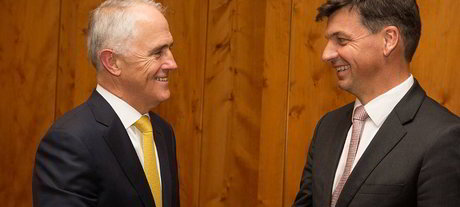Cabinet reshuffle unites digital agendas

It has been received as both an attempt to revitalise the government’s digital transformation efforts and a political move designed to reinforce support for a rising star in the Liberal ranks. No matter the motivation, however, Prime Minister Malcolm Turnbull’s appointment of MP Angus Taylor into a role with special responsibilities for digital transformation will leave a mark on the expanding effort that Turnbull has spearheaded.
Taylor was named Assistant Minister to the Prime Minister during this weekend’s cabinet reshuffle, which was occasioned by the resignation of long-serving ministers Mal Brough, Andrew Robb and Warren Truss. This, combined with the need to fill vacancies left by former Cities Minister Jamie Briggs and former Human Services Minister Stuart Robert, left Turnbull with several portfolio holes to fill — and Taylor scored both cities and digital transformation efforts.
Regardless of the truth of suggestions that the move was a clever political ploy to prop up Taylor’s position in the face of an internal party challenge, the involvement of Taylor in the digital transformation agenda puts a new twist on the evolving history of the Turnbull-created Digital Transformation Office (DTO), which Turnbull retained within his own Department of Prime Minister and Cabinet during a shuffle last September.
In announcing Taylor’s appointment, Turnbull referred to the portfolios as “key, whole-of-government areas” that would be driven by his leadership into the future. Taylor professed a long-running “interest and involvement in digital innovation” and called for ongoing change to improve government service delivery.
“Government needs to be clever with its services and systems, if we are to deliver better health, education and welfare while containing growth in spending,” he said, adding that Australia’s cities are struggling with issues of “affordability, amenity and congestion”.
Taylor, who was elected to the largely rural NSW electorate of Hume in 2013, is a Rhodes Scholar who previously studied law and economics before holding consulting and executive positions in a number of rural agricultural interests. His appointment will dovetail with the work being done by the DTO under the guidance of CEO Paul Shetler (read the GTR interview here), whom Turnbull appointed last year to head the fledgling transformation centre of gravity.
“It’s good to see a dedicated resource being given the opportunity to focus on the challenges of improving innovation and digital transformation for government,” former federal government CIO Glenn Archer — himself no stranger to driving change at the government level — told GTR in the wake of the announcement.
Yet Taylor’s appointment to the cities portfolio — a recent redrawing of Hume’s boundaries extends his electorate into Sydney’s outer suburbs — may become an opportunity not only to drive digital transformation within government, but to reinforce smart-city agendas that are already emerging as key drivers for improvement of government services.
Such services include not only the online-transactional areas being explored by the DTO, but also extend towards operational issues: a recent Cisco Systems survey of citizen expectations found strong interest in the use of new technologies to optimise the functioning and management of cities. Some 70% of respondents, for example, believe real-time data could improve management of water storage, while 82% see such systems as improving understanding of changes in stormwater systems.
Trials of water meters in Townsville and smart-energy infrastructure in Geraldton reflect a growing global movement marked by efforts such as the US government’s Global City Teams Challenge (held last year and in 2014), highlight some of the uses for new infrastructure — and suggest some of the areas where Taylor’s dual-pronged new responsibilities might complement each other.
Effective exploitation of emerging Internet of Things (IoT) models will be crucial in realising these benefits through large numbers of sensors working together, Cisco ANZ Director of Consulting Darren Scott recently told GTR — while noting the importance of strong, centralised government involvement of the type that Taylor will be working to provide.
“A lot of the smart-city debate in recent years has been around technology, and there is a technology element to it,” Scott said. “But there is even more around how the government is organised to be able to provide these services — how they build a consistent experience across the different silos within government, and how they provide services around that.”
Since those services often cross political and cultural boundaries — a train line, for example, may pass through several local council areas as well as state-government and Commonwealth catchments — high-level government coordination is invaluable in delivering transformational change to cities.
“You’re starting to see that this needs to be a coordinated approach between local, state and federal governments to facilitate that,” said Scott.
Encrypted apps, AI, and cloud surveillance in policing
How Australia and New Zealand will be using technology to fight crime in 2026.
AI policy needs to protect future Australians
The genie is out of the bottle with AI and it's clear what corporate leaders are using their...
Agentic AI could be Australia's productivity superpower if we seize it
Government agencies have an opportunity to lead by example and embrace AI technology to solve...




